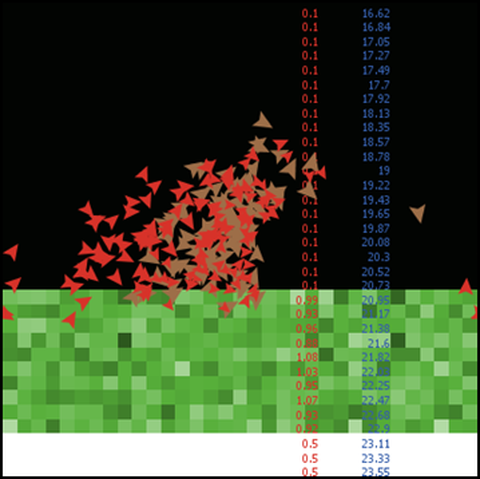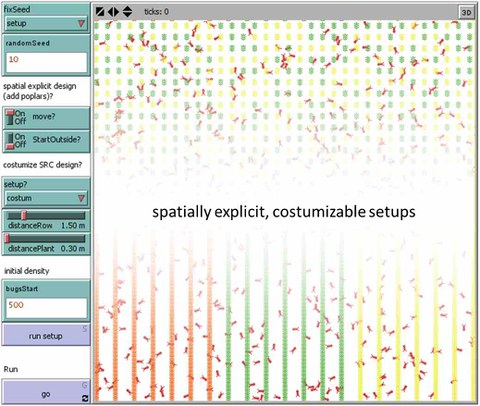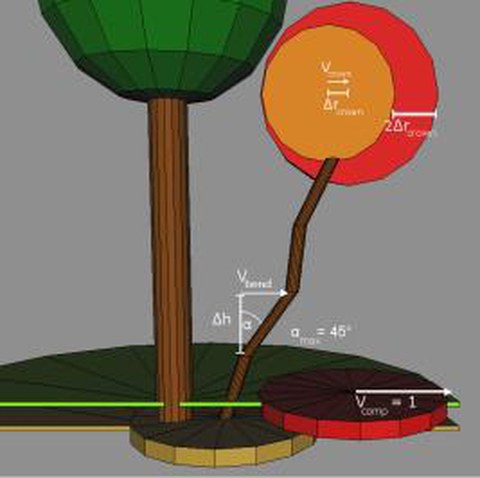Models
Simulation models are a central tool of research at our chair. We apply individual- and agent-based models (IBM / ABM), cellular automaton as well as systems of differential equations. Methods of applied and spatial statistics (statistical models) complete our toolbox. In the following, a brief description of some simulation models is given.
pyMANGA | BORNEO | SERBIK | MANGA | PlasmidomeIBM | PINUS-Syria (IBM) | PeatFire | PlasSim | IPS-SPREADS | DEB-IBM Krill Model | Bettina | PlasmidActionIBM | ASPIK | mesoFON
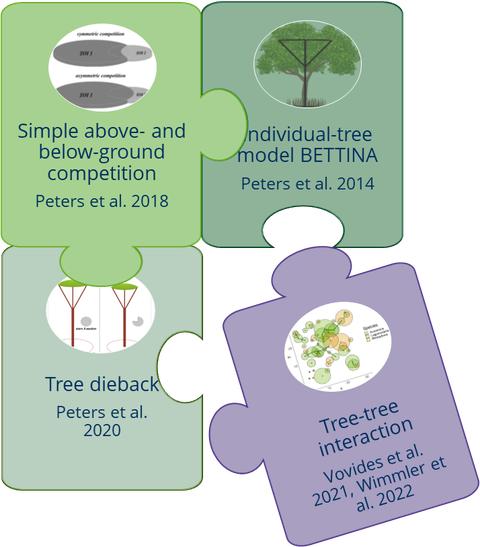
Puzzle illustrating the concept of the pyMANGA software platform for modular model building
pyMANGA
A modular, open and extendable software platform for modeling of forest and vegetation dynamics.
Check out and contribute building blocks to pyMANGA here:
https://pymanga.forst.tu-dresden.de/
Contact: Marie-Christin Wimmler
Further information: Article in Environmental Modelling & Software
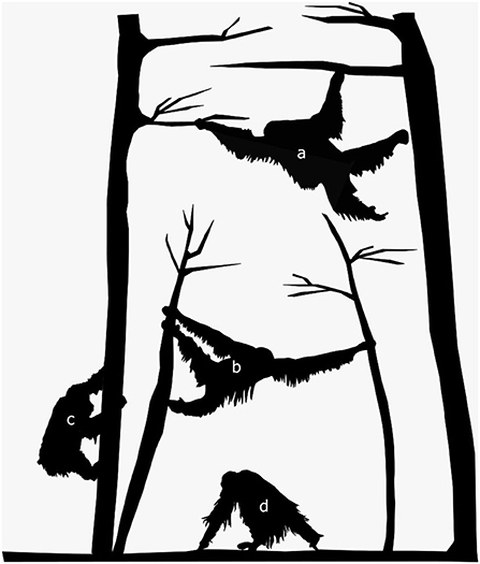
Simulated orangutan locomotion types: brachiation (a), sway (b), tree climbing (c) and terrestrial walk (d)
BORNEO
Agent-based model describing the arboreal movement of primates. It simulates orangutans performing activities with a motivation to balance energy intake and expenditure through locomotion. They use different locomotion types, depending on the connectivity of trees. Due to forest disturbances, orangutans may adapt to employ more terrestrial, as opposed to arboreal, movements potentially prolonging the search for fruiting and nesting trees. This can impact activity patterns, available energy budget and finally the fitness of orangutans. Thus, the model can serve as a tool to investigate the direct impact of forest changes and disturbances on the behavior of species such as orangutans.
Contact: Kirana Widyastuti
Further Information: Article in Frontiers in Ecology and Evolution

Advection field of the Southern Ocean (blue lines), which is used to model the spatial displacement of krill
SERBIK
A seasonally regulated bioenergetic krill growth model that simulates the life history (growth, energetics and reproduction) of Antarctic krill throughout its life cycle under given environmental conditions. It is used to assess the impact of global change on the development and fitness of Antarctic krill in a future Southern Ocean.
Contact: Dominik Bahlburg
Further information: Article in Ecological Modelling
The MANgrove–GroundwAter feedback model (MANGA)
Process based coupling of groundwater flow model to agent-based mangrove model - a tool to find explanation for mangrove zonation.
Contact: Jasper Bathmann
Further information: article in Ecological Modelling
The MANgrove-GroundwAter feedback model (MANGA) © Jasper Bathmann
PlasmidomeIBM
An individual-based model of the plasmidome that demonstrates how intra- and intercellular competition between diverse plasmid types affects the evolution of plasmid communities and the persistence of plasmid-encoded antibiotic resistance.
Contact: Martin Zwanzig
Further information: Preprint auf bioRxiv
The evolution of a plasmid community - simulated by the PlasmidomeIBM (https://github.com/mzwanzig/PlasmidomeIBM). © Martin Zwanzig
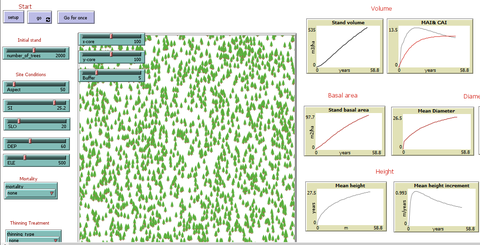
NetLogo interface of the Pinus Brutia IBM
PINUS-Syria (IBM)
The model simulates the growth and mortality of Pinus brutia influenced by distance-independent competition under different site conditions. It can be used to optimize rotation age and thinning regime.
Contact: Tammam Suliman
Further information: Article in Forest Systems
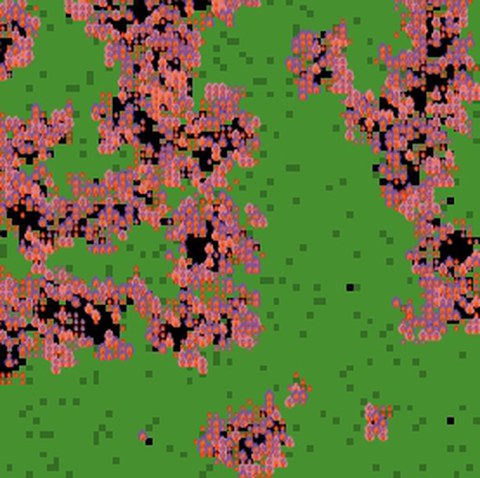
Model world showing the simulated fire spread
PeatFire
PeatFire is a simple individual-based model which simulates fire occurrences in a virtual tropical peatland ecosystem. It involves not only fire on the surface (above-ground) but also below-ground fire. The model tries to simulate how fire could spread from the peat surface to underneath and produce dynamic pattern of burnt patches.
Contact: Kirana Widyastuti
Further information: article in International Journal of Wildland Fire
https://peatfire-abm.github.io/
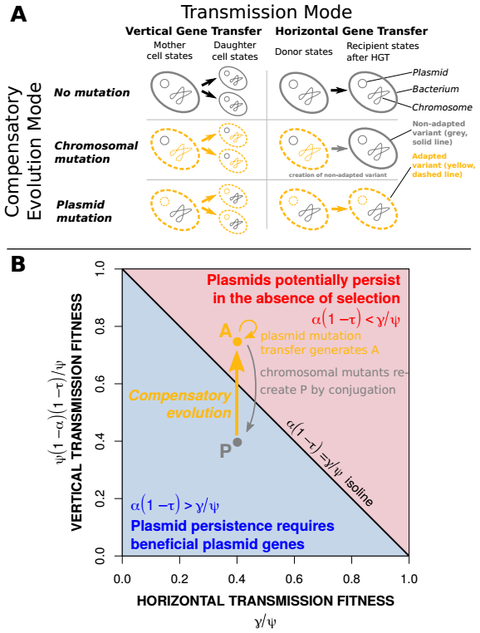
The type of compensatory evolution determines the capabilities for the transmission of a compensatory mutation (A), which has consequences on plasmid fitness (B).
PlasSim - Plasmid population dynamics Simulator
The model consists of three ordinary differential equations describing the dynamics of plasmid-free bacteria, F, nonadapted plasmid bearers, P, and adapted plasmid bearers, A, respectively. It shows how different localizations of genetic adaptations affect the dynamics of a population. An interactive web app can be used to run simulations with self-defined parameters and download the results.
Contact: Martin Zwanzig
Further information: article in mSystems
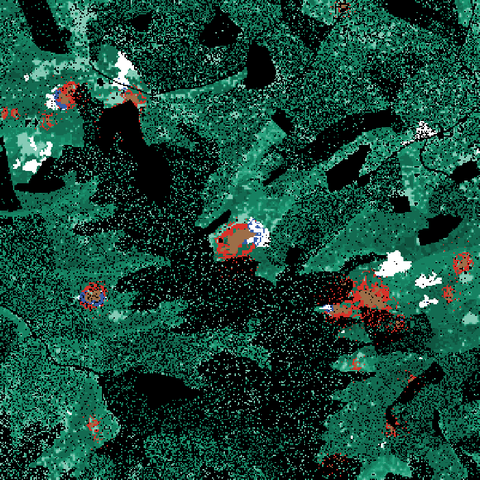
Model world of IPS-SPREAD showing a forest infestion
IPS-SPREADS
Integrates GIS data on tree allocation into the model IPS (Infestation Pattern Simulation, Kautz et al. 2014) to perform predisposition and risk assessment of bark beetle infestations.
Contact: Bruno Walter Pietzsch
Further information: Article in Frontiers in Forests and Global Change
DEB-IBM Krill Model
Simulates the Performance of Krill vs. Salps to withstand a warming Southern Ocean.
Contact: Jürgen Groeneveld
Further information: article in Nature Ecology & Evolution
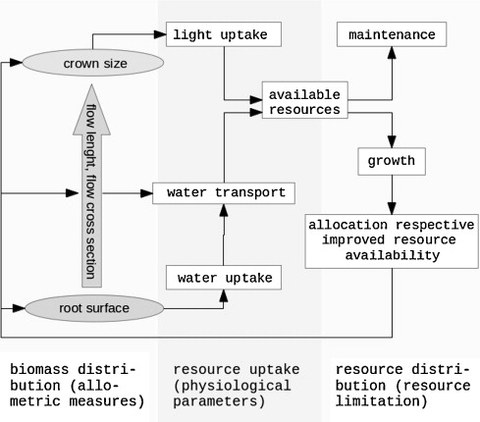
Model structure of 'Bettina'
Bettina
Mechanistic model for tree growth and plasticity based on hydraulic architecture
Contact: Ronny Peters
Further information: article in Ecological Modelling
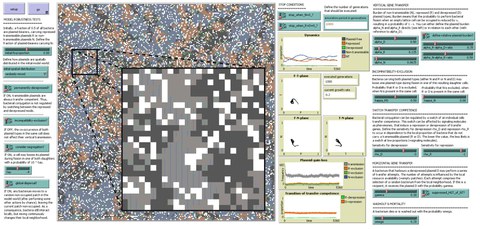
GUI snapshot listing all customizable model definitions along with a short explanation and magnification of a model world view showing how plasmids reside as linear elements on bacteria (in lightgrey); Plasmid-free cells are darkgrey; Empty space is white
PlasmidActionIBM
Simulates the dynamics of a single plasmid type in a clonal bacterial population or its intra- and intercellular interaction with another. A distinction is made between non-transmissive and conjugative plasmid types. For the latter, spatial signals control the expression of transfer genes and thus conjugation.
Contact: Martin Zwanzig
Further information and full model code: article in Plasmid
ASPIK
Simulates poplar leef beetles in short rotation coppice.
Further information: publication in 'Bioenergy from Dendromass for the Sustainable Development of Rural Areas'
mesoFON
Mangrove forest model with crown plasticity.
Further information: website, publication

